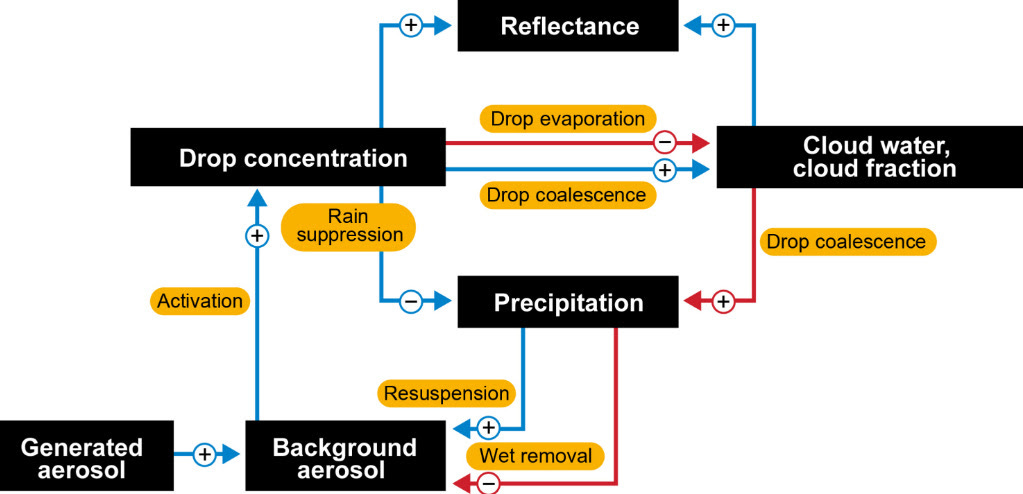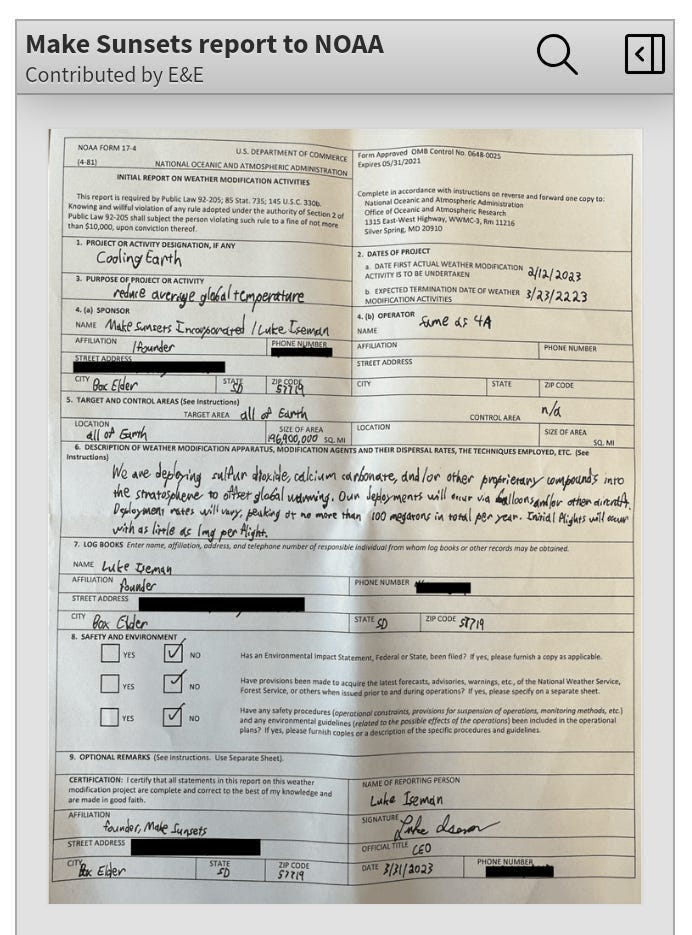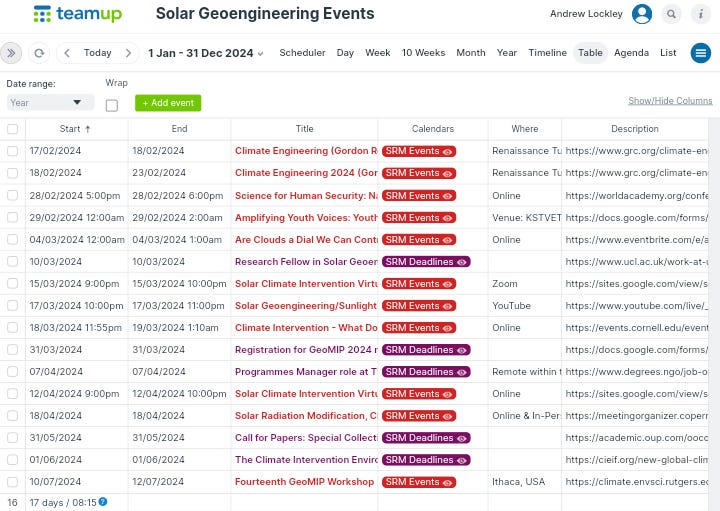The Solar Geoengineering Updates Newsletter (March'2024)
Welcome to the Solar Geoengineering Updates Newsletter, a monthly newsletter that updates you on the developments of everything SRM-related.
RESEARCH PAPERS
Public perceptions and support of climate intervention technologies across the Global North and Global South
Baum, C. M., Fritz, L., Low, S., & Sovacool, B. K. (2024). Public perceptions and support of climate intervention technologies across the Global North and Global South. Nature Communications, 15(1), 2060.
Hemispherically symmetric strategies for stratospheric aerosol injection
Zhang, Y., MacMartin, D. G., Visioni, D., Bednarz, E. M., & Kravitz, B. (2024). Hemispherically symmetric strategies for stratospheric aerosol injection. Earth System Dynamics, 15(2), 191-213.
Physical science research needed to evaluate the viability and risks of marine cloud brightening
Feingold, G., Ghate, V. P., Russell, L. M., Blossey, P., Cantrell, W., Christensen, M. W., ... & Zheng, X. (2024). Physical science research needed to evaluate the viability and risks of marine cloud brightening. Science Advances, 10(12), eadi8594.
Change in Wind Renewable Energy Potential under Stratospheric Aerosol Injections
Baur, S., Sanderson, B. M., Séférian, R., & Terray, L. (2024). Change in Wind Renewable Energy Potential under Stratospheric Aerosol Injections.
Stratospheric circulation response to stratospheric aerosol injections remains uncertain
Diallo, M., Dunker, N., Eichinger, R., Ploeger, F., Garny, H., Ern, M., ... & Hegglin, M. (2024). Stratospheric circulation response to stratospheric aerosol injections remains uncertain.
Solar Geoengineering: Assessing Whether Lack of Scientific Evidence Justifies Halting Solar Geoengineering Research
Lonkar, A. (2024). Solar Geoengineering: Assessing Whether Lack of Scientific Evidence Justifies Halting Solar Geoengineering Research. Journal of Science & Technology, 5(2), 57-68.
Trends in integrated assessments of solar radiation modification considering its side-effects
Kosugi, T. Trends in integrated assessments of solar radiation modification considering its side-effects.
A Proposal of Geoengineering Method as Global Warming Countermeasure: Stratospheric O3 Increase to Reduce Earth's Surface Temperature
Ohmori, T. (2024). A Proposal of Geoengineering Method as Global Warming Countermeasure: Stratospheric O3 Increase to Reduce Earth's Surface Temperature.
Simulating the Volcanic Sulfate Aerosols From the 1991 Eruption of Cerro Hudson and Their Impact on the 1991 Ozone Hole
Case, P. A., Colarco, P. R., Toon, O. B., & Newman, P. A. (2024). Simulating the volcanic sulfate aerosols from the 1991 eruption of Cerro Hudson and their impact on the 1991 ozone hole. Geophysical Research Letters, 51(5), e2023GL106619.
The El Niño response to tropical volcanic eruptions and geoengineering
Kroll, C., & Wills, R. J. (2024). The El Niño response to tropical volcanic eruptions and geoengineering (No. EGU24-11374). Copernicus Meetings.
Impacts of ice-nucleating particles on cirrus clouds and radiation derived from global model simulations with MADE3 in EMAC
Beer, C. G., Hendricks, J., & Righi, M. (2023). Impacts of ice-nucleating particles on cirrus clouds and radiation derived from global model simulations with MADE3 in EMAC. EGUsphere, 2023, 1-29.
The role of sulfur injection strategy in determining atmospheric circulation and ozone response to solar geoengineering
Bednarz, E., Visioni, D., Butler, A., Zhang, Y., MacMartin, D., & Kravitz, B. (2023). The role of sulfur injection strategy in determining atmospheric circulation and ozone response to solar geoengineering. In XXVIII General Assembly of the International Union of Geodesy and Geophysics (IUGG). GFZ German Research Centre for Geosciences.
Exploring ship track spreading rates with a physics-informed Langevin particle parameterization
McMichael, L. A., Schmidt, M. J., Wood, R., Blossey, P. N., & Patel, L. (2024). Exploring ship track spreading rates with a physics-informed Langevin particle parameterization. EGUsphere, 2024, 1-33.
World in the making: On the global visual politics of climate engineering
Benner, A. K., & Rothe, D. (2024). World in the making: On the global visual politics of climate engineering. Review of International Studies, 50(1), 79-106.
Severe Global Cooling After Volcanic Super-Eruptions? The Answer Hinges on Unknown Aerosol Size
McGraw, Z., DallaSanta, K., Polvani, L. M., Tsigaridis, K., Orbe, C., & Bauer, S. E. (2024). Severe global cooling after volcanic super-eruptions? The answer hinges on unknown aerosol size. Journal of Climate, 37(4), 1449-1464.
Does the Asian Summer Monsoon Play a Role in the Stratospheric Aerosol Budget of the Arctic?
Graßl, S., Ritter, C., Tritscher, I., & Vogel, B. (2024). Does the Asian Summer Monsoon Play a Role in the Stratospheric Aerosol Budget of the Arctic?. EGUsphere, 2024, 1-39.
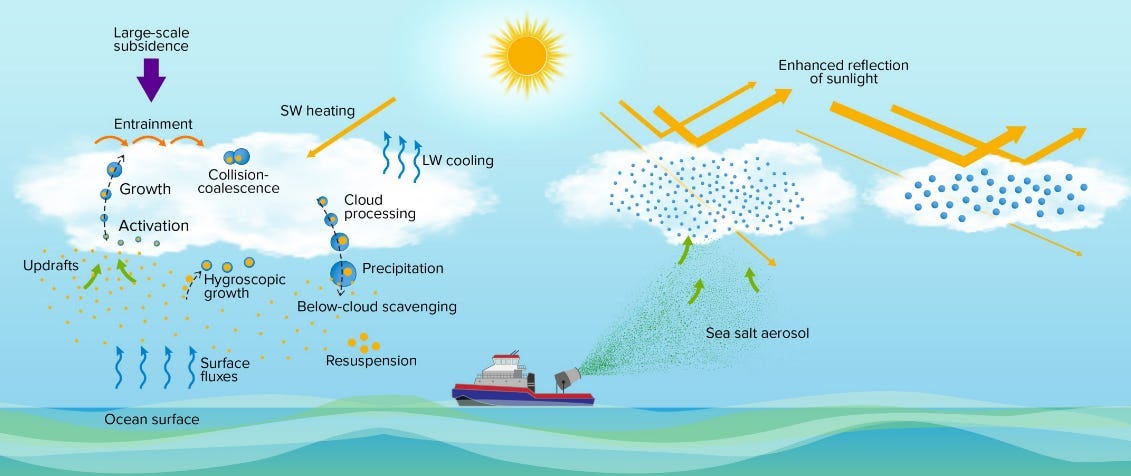
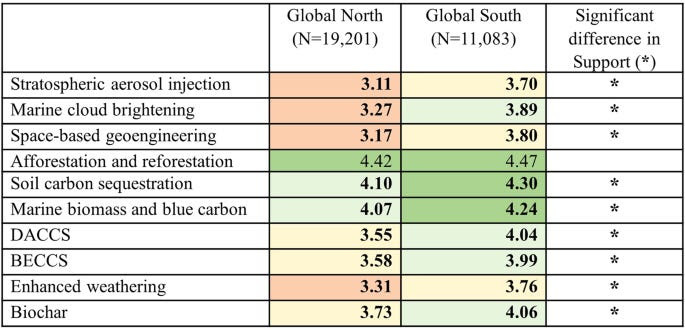
CONFERENCE PAPERS
Multi-model simulation of solar geoengineering indicates avoidable destabilization of the West Antarctic ice sheet
Moore, J., Chen, Y., Yue, C., Jevrejeva, S., Visioni, D., Uotilla, P., & Zhao, L. (2024). Multi-model simulation of solar geoengineering indicates avoidable destabilization of the West Antarctic ice sheet (No. EGU24-7071). Copernicus Meetings.
Exploring the impacts of changes in solar radiation on ecohydrological variables
Wang, Y., Meili, N., & Fatichi, S. (2024). Exploring the impacts of changes in solar radiation on ecohydrological variables (No. EGU24-7258). Copernicus Meetings.
Anticipating Risk: Deconstructing and reconstructing risk-risk analysis as a tool for solar geoengineering governance
McLaren, D. (2024). Anticipating risk: deconstructing and reconstructing risk-risk analysis as a tool for solar geoengineering governance (Traditional Open Panel P191: Exploring Anticipatory Governance)
Idealized modeling of uncooperative two-actor SRM deployment
Boucher, O., Määttänen, A., Lurton, T., & Ravetta, F. (2024). Idealized modeling of uncooperative two-actor SRM deployment (No. EGU24-6144). Copernicus Meetings.
WEB POSTS
NOAA gets dire warning about solar geoengineering (E&E News)
Scientists Are Tinkering With Clouds to Save the Great Barrier Reef (WIRED)
Permitting for mCDR and mSRM (US EPA)
When is ignorance the best strategy? (Plan A+)
Divisive Sun-dimming study at Harvard cancelled: what’s next? (Nature)
Thinking fast and slow about SRM (Plan A+)
Brief Reflections On The SCOPEX Advisory Committee And Implications For Research Governance (DSG)
Roll The Dice To Save The Arctic? (Global Climate Risks)
A Controversial SRM Resolution Was Withdrawn at UNEA-6: Here’s Our Takeaway (DSG)
Tennessee Senate passes bill based on 'chemtrails' conspiracy theory: What to know (The Tennessee)
Harvard has halted its long-planned atmospheric geoengineering experiment (MIT Technology Review)
How rerouting planes to produce fewer contrails could help cool the planet (MIT Technology Review)
Degrees-funded scientists lead key discussions at Gordon Research Conference (The Degrees Initiative)
Can’t Solve a Problem — Take a Step Back and Share It (Medium)
Effects of geoengineering must be urgently investigated, experts say (The Guardian)
The Best Way to Find Out if We Can Cool the Planet (The New York Times)
Climate change: The 'insane' plan to save the Arctic's sea-ice (BBC)
Two new Mexico teams to explore impacts of SRM on heatwaves and biodiversity loss (The Degrees Initiative)
Countries failed to agree first steps on solar geoengineering at the UN. What went wrong? (Legal Planet)
How You Can Easily Delay Climate Change Today: SO2 Injection (Uncharted Territories)
The global conversation about solar geoengineering just changed at the UN Environment Assembly. Here’s how (Legal Planet)
The Geoengineering Question (The Climate Brink)
Improving Simulations of Cirrus Cloud Thinning by Utilizing Satellite Retrievals (ESS OPEN ARCHIVE)
Scientists want to build 62-mile-long curtains around the 'doomsday glacier' for a $50 billion Hail Mary to save it (Business Insider)
Icy reception for plan to 'save' Venezuela's last glacier (Phys.Org)
DISCUSSIONS
Would stratospheric balloons that released hydrogen into the stratosphere add to warming?
THESIS
Assessing the Potential of Cirrus Cloud Thinning through Cloud Chamber Experiments and Parcel Model Simulations
REPORT
Stratospheric Controlled Perturbation Experiment (SCoPEx) Advisory Committee-Final Report
JOB OPPORTUNITY
Programmes Manager role at The Degrees Initiative | Remote within the United Kingdom | Deadline: 7 April 2024
“The Degrees Initiative is a UK-based charity that builds the capacity of developing countries to evaluate solar radiation management geoengineering (SRM), a controversial proposal for reducing some impacts of climate change. Degrees is neutral on whether SRM should ever be used, but we believe that developing countries should be empowered to conduct their own research and to play a central role in SRM discussions. The initiative has been registered as a UK charity since 2021 but operated for ten years before that as the Solar Radiation Management Governance Initiative (SRMGI). Our work receives worldwide coverage and widespread acclaim.”
PhD position on climate modelling of aerosol-cloud interactions at ETH Zurich (IAC-ETH)
“The Atmospheric Physics Group of Prof. Ulrike Lohmann at the Institute for Atmospheric and Climate Sciences at ETH Zurich (IAC-ETH) invites applications for a 3 – 3.5-year PhD position within the project "Glaciogenic seeding on mixed-phase clouds for radiation management (GLANCE)", funded by the Solar Radiation Management (SRM) programme of the Simons Foundation.
Solar and terrestrial radiation management is a climate intervention approach to modify the Earth's radiation budget by cooling the planet and mitigating some of the negative impacts from global warming. As a new alternative to solar radiation management proposals such as stratospheric aerosol injection, terrestrial radiation management has the potential to also mitigate polar warming during winter. In particular, a new method of mixed-phase cloud thinning (MCT) has recently been proposed, based on seeding supercooled liquid clouds with ice-nucleating particles (INPs). This causes these clouds to glaciate and precipitate, allowing more longwave radiation emitted to space. However, cloud glaciation is still poorly represented in climate models, so the risks and potential of this and other INP-based climate solutions remain uncertain. GLANCE aims to improve our understanding of cloud glaciation and MCT in order to increase our range of options in the event of a climate emergency and to minimise their potential risks.
Our group has long-standing experience in the representation of cloud glaciation and cloud ice in climate models. In addition, a wide range of computational resources for regional and climate modelling are available in our group and at ETH Zurich.”
UPCOMING EVENTS
(NEW) Solar Climate Intervention Virtual Symposia#10 | 12 April 2024
(NEW) Solar Radiation Modification, Clouds, Aerosols, and their Impacts on the Biosphere and Earth System | EGU General Assembly | 18 April 2024
(NEW) Fourteenth GeoMIP Workshop | Ithaca, USA | 10-12 July 2024
GUIDELINES:
Sync selected events to your default calendar in these simple steps:
1) Click on the event you want to sync.
2) Tap the menu icon (three vertical lines) at the top left.
3) Choose 'Share.'
4) Pick your default calendar.
5) Save the event.
Sync the entire Teamup Calendar to your default calendar with these simple steps:
1) Tap the menu icon (three vertical lines) at the top right.
2) Choose 'Preferences.'
3) Click 'iCalendar Feeds.'
4) Copy the URL shown for 'Solar Geoengineering Events / SRM Deadlines.'’
5) Paste the URL into your default calendar settings (Open Google Calendar in your web browser if you are using Gcal).
6) Click 'Subscribe' or 'Add Calendar.'
For more detailed instructions, visit: https://calendar.teamup.com/kb/subscribe-to-teamup-icalendar-feeds/
You can directly sync all Solar Geoengineering events to your default calendars by pressing the link below:
PODCASTS
Warm pool & SAI - Günther | Reviewer 2 does geoengineering
"Moritz Günther tries valiantly to get @geoengineering1 to understand the atmospheric dynamics of SAI's impacts on the warm pool, but it's rather like watching him trying to train a baboon to use Photoshop - there's some engagement, and the occasional flash of comprehension before it all gets too much for him.
Günther, M., Schmidt, H., Timmreck, C., and Toohey, M.: Why does stratospheric aerosol forcing strongly cool the warm pool?, EGUsphere [preprint], https://doi.org/10.5194/egusphere-2024-429, 2024."
MCB with drones - Claudel | Reviewer 2 does geoengineering
“Christian Claudel comes on to explore the issues around using drones to distribute MCB particles. These are made by anti-solvent precipitation (much like diluting Ricard spirit). Despite @geoengineering1 being AN ACTUAL AUTHOR on the paper he still finds plenty of opportunities for nitpicking.
Paper: Marine-cloud brightening: an airborne concept
Christian Claudel, Andrew John Lockley, Fabian Hoffmann and Younan Xia
DOI 10.1088/2515-7620/ad2f71”
How to think about solar radiation management | Volts
“Even if greenhouse gas emissions halted entirely right now, we would continue to feel climate change effects for decades due to existing carbon dioxide in the atmosphere — and warming could accelerate, as we reduce the aerosol pollution that happens to be acting as a partial shield. In this episode, Kelly Wanser of nonprofit SilverLining makes the pitch for solar radiation management, the practice of adding our own shielding particles to the atmosphere to buy us some time while we step up our greenhouse gas reductions.”
Stratospheric dehydration - Schwarz | Reviewer 2 does geoengineering
“Joshua Schwarz explains how dispersing ice nucleating particles in one tiny region of the tropical tropopause layer off Northern Australia can address around 1pc of global warming. He also discusses his involvement in the SABRE stratospheric flights. Paper: Considering intentional stratospheric dehydration for climate benefits.
Other papers discussed:
-Pyrocumulonimbus affect average stratospheric aerosol composition (J. M. KATICH)
-Marine-cloud brightening: an airborne concept (Christian Claudel, Andrew John Lockley, Fabian Hoffmann and Younan Xia)”
Benjamin Sovacool and Chad Baum on global trends in public perceptions of climate technologies | Challenging Climate
“In this episode, we speak with Dr. Benjamin Sovacool and Dr. Chad Baum, about their newly published, high-impact paper, “Public Perceptions and Support of Climate Intervention Technologies across the Global North and Global South”. Join us as we discuss the key findings of their work, and how these findings can and should influence policy and governance methods.”
George Monbiot on environmentalism and climate activism | Challenging Climate
“George Monbiot is a renowned British author, The Guardian Columnist and environmental activist. George is the author of more than a dozen books, the most recent of which is Regenesis: Feeding the World without Devouring the Planet, and he was awarded the Orwell Prize for Journalism in 2022.
In this episode, we discuss topics of his insightful and provocative articles such as de-throning GDP, radical climate activism, the ‘wealth curse’ and contentious technologies such as nuclear energy, GMO and SRM.”
YOUTUBE VIDEOS
The Climate Solution That’s Either Brilliant or Insane | Kite & Key Media
“Lots of people are worried about climate change. Some of those people think the solution is … using science to manipulate the weather. It’s an idea called geoengineering — and it’s either brilliant or insane.
In recent decades, there’s been an enormous push to reduce carbon emissions. It hasn’t resulted in much progress. As a result, an increasing number of scientists and engineers have suggested we consider altering the weather to mitigate the worst effects of climate change. One of the major proposals is called “carbon capture”: literally pulling carbon dioxide back out of the atmosphere via machines or special plant life.
The other is called “geosolar engineering,” which involves blocking out the Sun … a bit. By reflecting some of the Sun’s energy back into space, it’s suggested that we could stabilize temperatures until we find a more permanent fix.
But while these options may be technically feasible — and while they’re surprisingly affordable — the political and moral considerations are massive. After all, who gets to determine the world’s climate?”
Satan balloon weather control | stratospheric aerosol transport and nucleation | AlideCid
“In this video, we look at the Satan balloon systems "stratospheric aerosol transport and nucleation. In September of last year, researchers in the UK undertook a unique high-altitude weather balloon experiment, releasing several hundred grams of sulfur dioxide into the stratosphere. This endeavor, revealed recently by MIT Technology Review, marks a potential breakthrough in the field of solar geoengineering. Solar geoengineering involves deliberate attempts to mitigate global warming by reflecting sunlight into space. While this particular experiment was not a direct test of geoengineering, it aimed to evaluate a low-cost, recoverable balloon system for potential small-scale geoengineering research or a distributed deployment using multiple balloons.”
Luke Iseman: Stratospheric Creativity | INKtalks
“How would you like to make a few clouds, asks Luke Iseman, Founder and CEO of Make Sunsets. Sounds like fantasy fiction, but deploying reflective clouds into the stratosphere is very much one of the solutions being developed to cool the Earth’s atmosphere. Luke showcases his groundbreaking approach on the stage of INK 2023: Futureverse, using balloons released into the atmosphere's stratospheric layer. Watch to learn more about his inspiring journey and the idea of 'cooling credits.'”
Benjamin Sovacool and Chad Baum on global trends in public perceptions of climate technologies | Challenging Climate
“In this episode, we speak with Dr. Benjamin Sovacool and Dr. Chad Baum, about their newly published, high-impact paper, “Public Perceptions and Support of Climate Intervention Technologies across the Global North and Global South”. Join us as we discuss the key findings of their work, and how these findings can and should influence policy and governance methods.”
AMOC Collapse: Timing & Impacts, with Climate Scientist René van Westen | Climate Chat
“In this Climate Chat episode, I interview Dr. René van Westen, a climate scientist whose research focuses on tipping points. Dr. Westen is a postdoctoral researcher at Utrecht University in the Netherlands. René was lead author of a recent paper titled "Physics-based early warning signal shows that AMOC is on tipping course". Here is a link to the paper:https://www.science.org/doi/10.1126/sciadv.adk1189
PRAG 25 February 2024 | Robbie Tulip
“Planetary Restoration Action Group. Begins with a discussion of the work of Stephen Salter, and the role of albedo loss in global warming.”
We Need to Start Climate Engineering Soon, New Study Says | Sabine Hossenfelder
Climate engineering is the cheapest way to get us out of this unfolding climate disaster, but how do we do it? Two new papers have recently been released - one discussing the need to start stratospheric aerosol injections soon and the other introducing a new method of climate engineering. What are the pros and cons of stratospheric aerosol injections? What is this new method? Let’s have a look.
Paper 1: https://agupubs.onlinelibrary.wiley.com/doi/10.1029/2023GL106132
Paper 2: https://www.science.org/doi/10.1126/sciadv.adk0593
2023 2024 A New Era of Policy in Solar Geoengineering KCEP Digest 59 Solar Geoengineering | METERRORIST MEDIA
2024 Towards a Non Use Regime on Solar Geoengineering Lessons from International Law and Governance | METERRORIST MEDIA
Solar Climate Intervention Virtual Symposium 9 (Daniel Hueholt & Prof David Keith) | Solar Climate Intervention Talks
“Solar Climate Intervention Virtual Symposium 9
Daniel Hueholt (Colorado State University, USA): "Climate speeds help frame relative ecological risk in future climate change and stratospheric aerosol injection scenarios."
Prof. David Keith (University of Chicago, USA): "Solar geoengineering could start soon if it is small."
Solar Geoengineering/Sunlight Reflection Methods: Safe, Effective, Needed? w/ Doug MacMartin | Climate Chat
“In this Climate Chat episode, we interview Cornell climate scientist Douglas MacMartin. Doug researches climate intervention techniques including Sunlight Reflection Methods (SRM, aka Solar Radiation Management or Solar Geoengineering). We will discuss how SRM can be achieved, how safe it is, how does SRM side effects compare with the side effects of not doing SRM, and why SRM may be needed very soon.”
MEERTALK March 2024 - Tim Garrett | MEER SRM
“Clouds play a controlling role in the atmosphere, in large part because they cool it during daytime by reflecting sunlight to space. In recent decades clouds have been a primary target for climate modification because the addition of tiny aerosol particles to clouds can clearly be shown to make them brighter. However, clouds are highly dynamic creatures, and their overall response at the global scales that matter most to climate change is much harder to measure. and their overall response at the global scales that matter most to climate change is much harder to measure.
Tim Garrett is a Professor of Atmospheric Sciences at the University of Utah. His research interests focus on the measurement and modeling of clouds and precipitation and their role in weather and climate.”
Climate Intervention: What Do We Know, What Do We Need to Know, Should We Know It? | Cornell Atkinson Center for Sustainability
Can You See Cosmic Rays on Hot Drinks? | The Action Lab
“Could electric charges or radiation trigger cloud droplets for CCT or MCB?”






